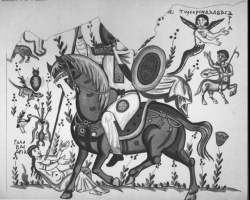Nubian Pregnancy Protection: Difference between revisions
No edit summary |
No edit summary |
||
| Line 1: | Line 1: | ||
[[File:Sisinios_at_Bawit.JPG|right| | [[File:Sisinios_at_Bawit.JPG|right|250px|Wall Painting of Saint Sisinios at Bawit]] | ||
'''Nubian Pregnancy Protection: A Saint Sisinios Amulet from Qasr Ibrim''' | '''Nubian Pregnancy Protection: A Saint Sisinios Amulet from Qasr Ibrim''' | ||
Revision as of 01:10, 17 December 2010

Nubian Pregnancy Protection: A Saint Sisinios Amulet from Qasr Ibrim
Ed.princ., apparatus and preliminary translation by Joost Hagen
Discussion and revised translation by Giovanni Ruffini
Object number 80-3-11/2, an amulet on paper excavated at Qasr Ibrim in 1980, was entered in the sequence of textual finds as NI 113, indicating that its excavators took it to be Old Nubian. In fact, with the exception of one word, the 28-line text is entirely Greek, and contains a medieval Nubian version of the legend of Saint Sisinios, a protective hero with over two thousand years of history in Mediterranean folklore. The provenance of the amulet is recorded as the northwest bastion, "A3 – 41 – LC1 – 30 – Room 4."<ref>“Qasr Ibrim Running Register of Textual Finds, 1978-1980” housed in the British Museum Qasr Ibrim Archive.</ref> This context indicates that the amulet dates no earlier than the late twelfth century AD. Thus, it is a remarkable example of the very late use of Greek in Lower Nubia, and as importantly, a remarkable example of Nubian Christianity’s adaptation of hagiographical traditions widespread in other areas of the Christian world.
Apotropaic heroes named swswny (Aramaic), Sisinios (Greek), and other variants appear to have their roots in a protective figure named Ssm. This protective figure first made its appearance in a Phoenician amulet in the seventh century BC.<ref>Stol 2000, 229.</ref> In Hellenistic and later versions of the story, the hero’s nemesis is a baby-stealing or baby-killing demon named "Iron" (sideros or werzelya in Aramaic and Ethiopic versions) or Gellou (in Greek versions).<ref>Stol 2000, 228.</ref> One trick this demon frequently employs is to masquerade as a midwife.<ref>Stol 2000, 230.</ref> Versions of this story gradually assimilated into Christianity in the form of Roman-era hagiographical accounts. In one Greek version, set in the reign of Trajan, the demon cannot vomit up one of her victims until she drinks from the breast of the baby’s mother.<ref>Naveh and Shaked 1985, 114, providing the Greek text and translation of the story given in Perdrizet 1922.</ref> In an Arabic synaxary based on a Coptic original, Saint Sisinios is the son of a member of Diocletian’s court.<ref>Naveh and Shaked 1985, 117.</ref> Sisinios is often depicted on a horse, as in the Trajanic version just mentioned, and depicted as a mounted military saint in a wall painting at Bawit.<ref>Clédat 1904, 80-81 with Plate 55.</ref> References to Sisinios frequently appear in texts intended to serve an apotropaic function. Ethiopian amulets designed to protect newborns include examples invoking the name of Susenios (Greek Sisinios).<ref>Halevy 1907.</ref>
The text we present here is a Greek version of a portion of the Saint Sisinios story, one with no direct relationship to the other known Greek versions. If we take the nemesis belselleia as the Greek basileia and suppose her to have been some member of the royal family, we may have a version close to that in the Arabic synaxary, depicting Sisinios as part of Diocletian’s court circle. From the closing lines of the text, this amulet seems to have invoked this Sisinios story to protect an unnamed daughter of Tittiko, or more specifically, to protect either her pregnancy or her recently born child. This text is thus a piece of Nubian magic to protect against the vagaries of child-birth.
The original has not been consulted. The text given here is produced by reference to photographs and transcripts located in the British Museum’s Qasr Ibrim Archive.
QI 80-3-11/2
<references/>